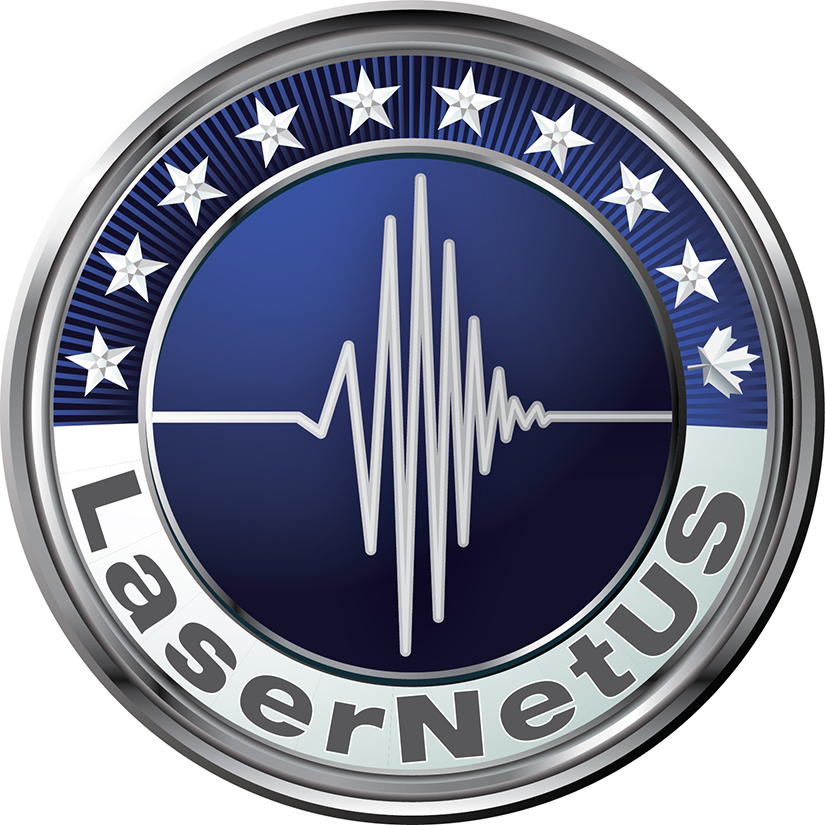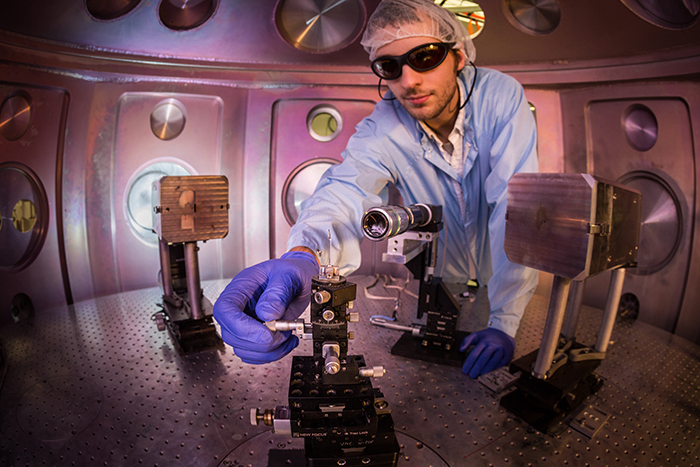LaserNetUS Opening New Frontiers of Laser Science Research
August 17, 2021
LaserNetUS, a network of 10 ultra-powerful laser facilities including LLNL’s Jupiter Laser Facility (JLF), was formed to strengthen the nation’s position in high-intensity lasers and laser-plasma research. In just three years, the program has made great strides toward achieving that goal.
So far, the Department of Energy (DOE)-supported consortium has conducted or approved 86 innovative experiments—out of 149 proposed experiments submitted—that will advance the frontiers of laser science, including some that will potentially push into new areas such as agriculture and cancer research.
 The LaserNetUS logo was designed by LLNL’s Brian Chavez and Mark Meamber.
The LaserNetUS logo was designed by LLNL’s Brian Chavez and Mark Meamber. And several LLNL scientists and researchers, including Félicie Albert, Tammy Ma, Robert Cauble, and Ronnie Shepherd, have been at the forefront of successfully leading LaserNetUS through its early stages, even in the middle of a global pandemic.
Albert, a staff scientist at NIF & Photon Science and the Joint High Energy Density Sciences organization, currently serves as LaserNetUS chair. Albert, who is also deputy director of LLNL’s High Energy Density Science Center and JLF, said the network’s progress so far is a testament to its collective strength.
“We’re not an individual set of facilities, we are a network where each facility is viewed as being complimentary to the others,” Albert said. “They each have their uniqueness and they each have something to bring to the network.”
Albert and Ohio State University’s Douglas Schumacher, current LaserNetUS vice chair, co-chaired the 2021 LaserNetUS User Meeting, held virtually Aug. 17 to Aug. 19. An honored guest kicked off the event: Nobel Prize in physics laureate Donna Strickland, a former LLNL staff scientist, delivered an open plenary address titled, “From nonlinear optics to high intensity laser physics.”
A 2018 National Academies of Sciences, Engineering, and Medicine report noted the United States developed and dominated high-intensity-power laser technology in the 1990s but had lost that lead to Europe and Asia. The report, “Opportunities in Intense Ultrafast Lasers,” recommended the DOE establish a broad national network that included universities, industry, and government laboratories. The DOE’s Office of Fusion Energy Sciences (FES) established LaserNetUS in August 2018.
The 10 LaserNetUS members are:
- Advanced Beam Laboratory, Colorado State University
- Advanced Laser Light Source, Université du Québec, Canada
- Berkeley Lab Laser Accelerator Center, Lawrence Berkeley National Laboratory
- Center for High Energy Density Science: Texas Petawatt Laser, University of Texas—Austin
- Center for Ultrafast Optical Science, University of Michigan
- Extreme Light Laboratory, University of Nebraska – Lincoln
- Jupiter Laser Facility, LLNL Physical and Life Sciences Directorate
- Laboratory for Laser Energetics: OMEGA EP, University of Rochester
- Matter in Extreme Conditions, SLAC National Accelerator Laboratory
- Scarlet Laser Facility, The Ohio State University
These are some of the most powerful lasers in North America, some nearing or exceeding a petawatt, meaning they can generate nearly 100 times the combined output of the world’s power plants in an ultrafast pulse shorter than a tenth of a trillionth of a second. These lasers can be used to re-create the universe’s most extreme conditions—such as those found in supernova explosions—to explore basic science, advanced manufacturing, and medicine.
The network works to accomplish its mission “by advancing the frontiers of laser science research, providing students and scientists with broad access to facilities that they wouldn’t have access to otherwise,” Albert said. “And we do that by fostering collaborations among researchers nationally and internationally.”
Before LaserNetUS was formed, there were only two places where scientists who did not work for a university or research institution that owned an expensive laser system could conduct the experiments they conceived unless they could arrange to collaborate with someone who did own one. These were the very-large-scale Laboratory for Laser Energetics and the intermediate-scale JLF. And only at JLF could scientists perform hands-on experiments themselves.
For the past dozen years, the JLF User Program has welcomed proposals from qualified U.S. and international principal investigators. A JLF Proposal Review Committee evaluated, ranked, and awarded beam time at no cost, along with technical assistance from Jupiter. LaserNetUS has expanded JLF’s user facility model to a larger network with a similar process, which opens doors to more laser scientists.
“Happily, JLF is now not the only game in town,” said Cauble, JLF director and LaserNetUS’s official facility liaison.
 Jackson Williams, a graduate student at the time, takes part in hands-on experimental work inside the Jupiter Laser Facility’s Titan laser. Williams is now a NIF staff scientist. Credit: Damien Jemison
Jackson Williams, a graduate student at the time, takes part in hands-on experimental work inside the Jupiter Laser Facility’s Titan laser. Williams is now a NIF staff scientist. Credit: Damien Jemison LaserNetUS assembled a Proposal Review Panel (PRP) to sift through proposed experiments submitted and select which ones go forward, matching it to the appropriate facility depending on its requirements.
“Some people need more laser energy, so they’ll go to JLF or the Texas Petawatt or OMEGA EP,” Albert said. “Some people need high repetition rate, so they will go to Colorado State University, Ohio State University, or the University of Nebraska, Lincoln. Some people need a ready-to-go x-ray source, so they’ll go to the Advanced Laser Light Source in Canada, while others need expertise in particle acceleration, so they’ll go to Berkeley.”
The community of laser researchers has responded enthusiastically. Nearly 400 participants have been involved in project proposals, including 144 scientists, 49 postdoctoral researchers, 116 graduate students, 17 undergraduate students, and 73 faculty members. They have represented 88 domestic and 35 international institutions.
Shepherd, a senior LLNL researcher, is the incoming elected chair of the newly formed LaserNetUS Users Group, which will act as the voice of the users and a liaison with the network’s leadership.
Two rounds of accepted experiments have been completed and a third is ongoing. The experiments have involved hydrodynamics, equation of state and warm dense matter, magnetization, ion acceleration and neutron sources, electron acceleration and photon sources, and high-intensity physics.
For example, teams from Los Alamos used Colorado State’s laser for tomographic imaging with a laser-driven gamma ray source. And numerous experiments in laser-plasma interactions have been conducted, which is important to fusion programs such as those conducted at NIF.
A paper recently published in Physical Review E described experiments measuring hot electron production using cone-shaped compound parabolic concentrator targets. The experiments were performed at the Texas Petawatt Laser and supported by LaserNetUS and LLNL’s Laboratory Directed Research and Development (LDRD) program. LLNL postdoctoral appointee Dean Rusby presented a talk about that research during the user meeting.
Albert has run weekly virtual meetings of network representatives. “It’s really great community effort,” she said. “We’ve written white papers, made presentations, reached out to the community. We have healthy discussions and debates and we’re all committed to making the network make progress.”
Stimulating Creativity
Ma, who leads the High-Intensity Laser High Energy Density (HED) Science Element in the NIF & Photon Science Advanced Photon Technologies (APT) program, volunteered her time to establish the PRP’s structure and how it evaluated proposals for technical excellence and broader impact. She has served as its chair through the first three rounds of proposals and was enthusiastic about the creativity laser researchers are displaying.
“What we’re starting to see more of are proposals for experiments that reach beyond the traditional realm of plasma physics,” Ma said. “In this last cycle, we awarded a proposal at the BELLA facility at LBNL to use laser-driven protons for tumor therapy. There was a proposal to use short-pulse-driven x rays for imaging plants and how they might uptake nutrients and water. There’s been some great work to develop neutrons as secondary sources.”
The PRP’s structure includes complete transparency about the review process, while ensuring there are no conflicts of interests from the reviewers “to make sure the PRP was a force for good and not a way of manipulating the type of science that was done,” she said.
Also, there are rules about how long any person (including the chair) can serve on the PRP so the network “stays vibrant because you always have new people coming in with new ideas,” she said. “It’s a true network that serves the community and not any one institution or any one individual.”
Working with LaserNetUS also brings added benefits to LLNL.
“It’s given us great exposure to the new crop of scientists that are being trained up now and who we potentially could hire in the future here at Lawrence Livermore,” Ma said.
LaserNetUS, she added, has demonstrated “a healthy laser ecosystem that we need in the U.S. to maintain leadership both in high-energy density (HED) expertise and the potential laser technologies that you can use these smaller scale facilities as a testbed for, and could later port over to NIF.”
The consortium is working together to draw up plans to upgrade facilities in ways that will complement the network’s overall capabilities and resources so all members can benefit.
“We’re still in the very early stages of LaserNetUS, so there’s still things that we’re working on,” Albert said. “We try to tackle all these things one by one. It is funded by DOE FES, but it’s really done with the support of the community. We do that because it’s a worthy effort.”
More Information:
“Nobelist’s Invention Helped Spark LLNL’s Short-pulse Laser Breakthroughs,” NIF & Photon Science News, October 11, 2018
"Reports Recommend Stepped-Up U.S. Investment in Fusion Energy,” NIF & Photon Science News, March 8, 2021
“Scientists Focus on Cone Targets to Enhance Temperature of Electron Beams,” LLNL News, June 24, 2021
—Benny Evangelista
Follow us on Twitter: @lasers_llnl



